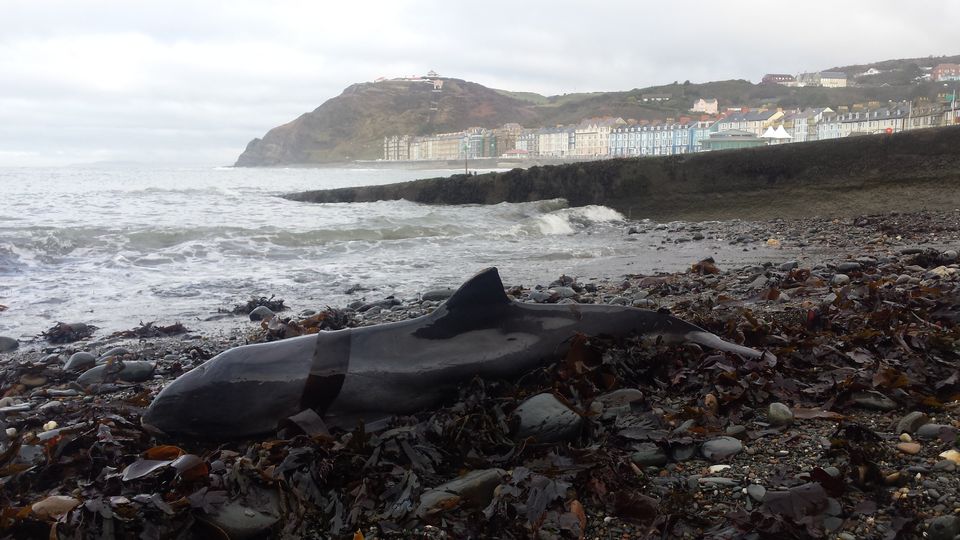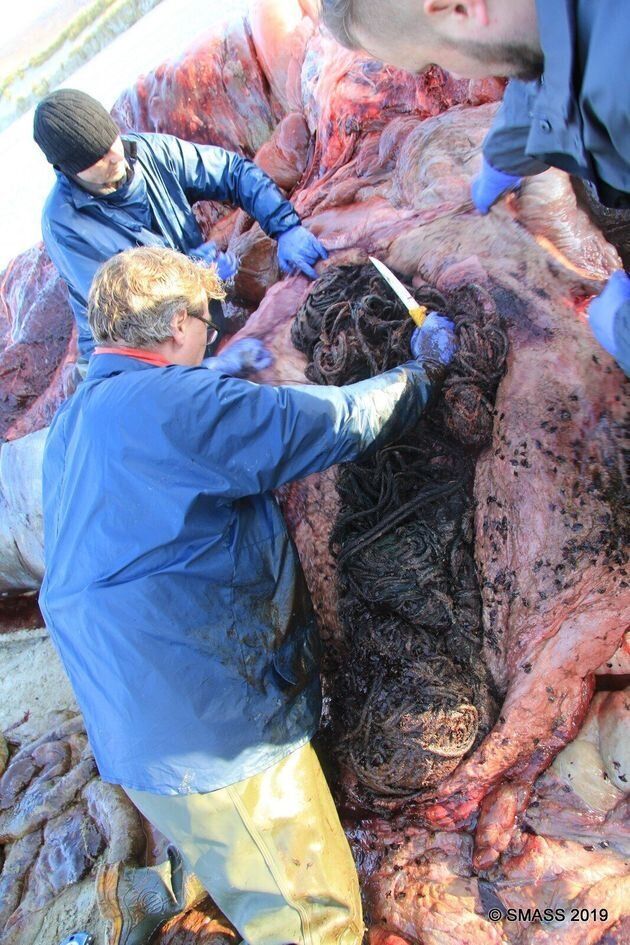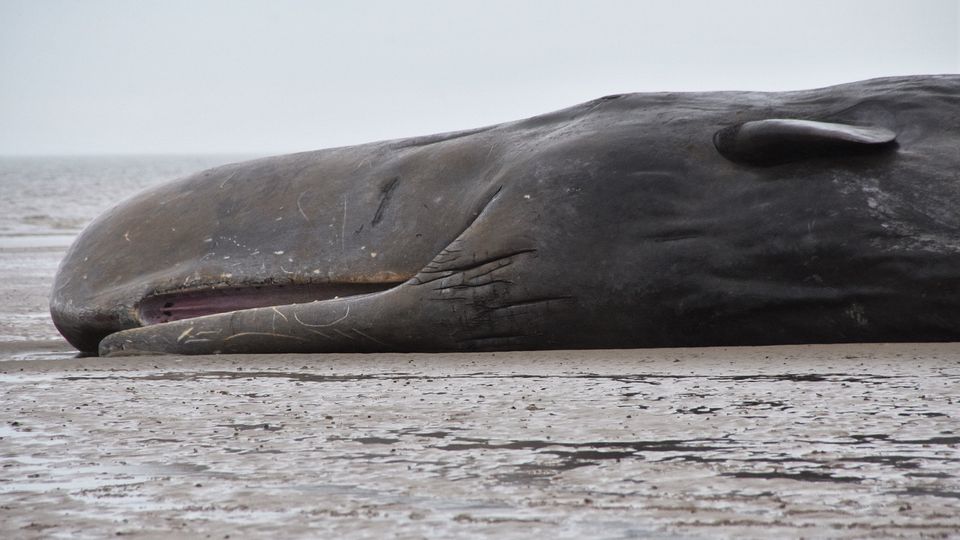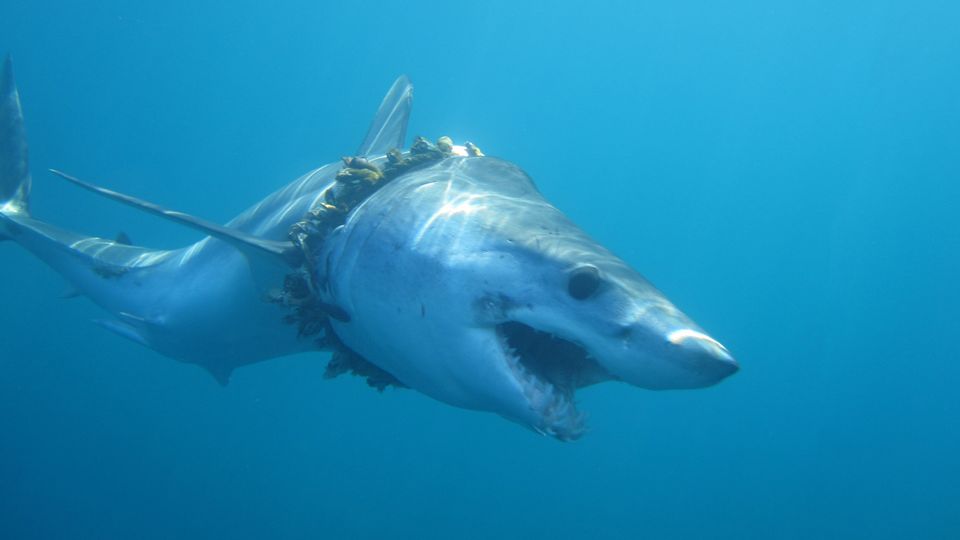Warning: Some graphic images below.
The harrowing sight of marine animals found either stranded and maimed by plastic rubbish or having ingested it is becoming ever more common.
Yet many researchers have been reduced to gathering data on such sad events through social media, meaning the true scale of the problem still isn’t clear.
Last week, a sperm whale that beached and died on the Isle of Harris was found to have an astonishing 100kg of plastic, ropes and other man-made rubbish in its stomach.

The Scottish Marine Animal Strandings Scheme, which attended the discovery, also found cups, bags, gloves and packing straps inside the whale, which may have compromised its digestive system.
In April a pregnant female sperm whale was found dead off the coast of Sardinia, Italy, with roughly 49lbs of plastic inside her. As well as the dead foetus, her body held rubbish bags, fishing nets and lines, tubes and a bag of washing machine liquid.
In another incident, a goose-beaked whale stranded off the coast of Norway had to be put down after scientists found 30 plastic bags and other plastic waste in his stomach.
The visibly sick, two-tonne whale was found starving due to a large amount of non-biodegradable waste clogging up his digestive system. Turtles frequently eat plastic bags, mistaking them for jellyfish and 90% of seabirds are believed to have plastic in their stomachs.
Plastics that enter the open ocean will inevitably sink, degrade into microplastics, or become entangled in or ingested by marine life.
A United Nations Environment Programme (UNEP) report published last month estimates that about eight million tonnes of plastic is dumped in the oceans worldwide every year, entering the food chain and maiming or killing marine life.

The same body says 100,000 marine animals die each year due to plastic pollution related causes, but last year the BBC put that estimate closer to 300,000 marine mammals and 400,000 seabirds.
If the higher rate continues, the Ellen MacArthur Foundation estimates that by 2050 there will 500 times the amount of plastic in our ocean that there is now. In other words, there will be more plastic than fish.
A scarcity of academic papers on the ingestion of plastics by marine animals has seen researchers increasingly turning to social media and the public to help them compile data.
This year, a study of dolphins, seals and whales washed up on British shores alone found plastic in the digestive system of every single one.
Scientists examined 50 animals from 10 different species that had died from a variety of causes.
All of them had “microplastic” particles, less than five millimetres across, in their stomachs and intestines.
The vast majority of the particles were synthetic fibres that may have been shed by clothes or fishing nets. Others were fragments of originally larger pieces that could have come from food packaging or plastic bottles.
‘Ominous’
Lead researcher Sarah Nelms, from the University of Exeter, said: “It’s shocking – but not surprising – that every animal had ingested microplastics.
“The number of particles in each animal was relatively low, an average of 5.5 particles per animal, suggesting they eventually pass through the digestive system, or are regurgitated.” Animals that died as a result of infectious disease had slightly higher numbers of particles than those killed by injury or other causes.
The team, whose findings appeared in the journal Scientific Reports in January, said bacteria, viruses and contaminants carried on the plastic were a cause for concern. Research shows the presence of plastic increases the amount of certain kinds of lethal bacteria from normal levels of 4% to 89%.
Species studied included the Atlantic white-sided dolphin, the bottlenose dolphin, the common dolphin, the grey seal, the harbour porpoise, the harbour seal, the pygmy sperm whale, Risso’s dolphin, the striped dolphin, and the white-beaked dolphin.
The research was supported by the environmental group Greenpeace.

Louise Edge, head of Greenpeace UK’s ocean plastics campaign, said: “It is ominous that every single marine mammal tested was found to have microplastics in their digestive system, and it shows the scale of plastic pollution in our seas.
“This is yet more evidence that the government and big businesses need to focus their efforts on drastically reducing the use and waste of plastics, to stem the flow of plastic pollution into our rivers and oceans and into the mouths of marine wildlife.”
In July, a global study of sharks and rays known to have become entangled in plastic debris found more than 1,000 examples, with a “significantly greater number of species” likely to be affected.
Scientists at the University of Exeter found reports of 1,116 of the creatures caught up in plastic in the world’s oceans after scouring existing studies and social media.
The true number is likely to be far higher, the researchers said, calling debris from land-based pollution and discarded fishing gear a “severely under-reported threat”.
The researchers reviewed existing studies and also appealed for information on Twitter, fearing that the issue had been pushed “under the radar” by threats such as over-fishing.
Co-author Professor Brendan Godley, co-ordinator of the university’s marine strategy, said: “Due to the threats of direct overfishing of sharks and rays, and ‘bycatch’ – accidental catching while fishing for other species – the issue of entanglement has perhaps gone a little under the radar.
“We set out to remedy this. Our study was the first to use Twitter to gather such data, and our results from the social media site revealed entanglements of species – and in places – not recorded in the academic papers.”
Dozens of species were affected including whale sharks, great whites, tiger sharks and basking sharks.
The majority of the entanglements involved abandoned, lost or discarded “ghost” fishing equipment.
There were also reports of the creatures, which are classed as elasmobranchs, trapped in plastic packing straps, bags, packaging, elastic cords and clothing.
The scientists acknowledged that entanglement is a “far lesser threat” than commercial fishing, but said it remains a “major animal welfare concern”, with possible conservation implications.
Authors of the study, published in Endangered Species Research, wrote: “If elasmobranchs are susceptible to entanglement in anthropogenic debris, this could have potential negative implications on rapidly declining populations.

“Entanglement can lead to starvation, suffocation, immobilisation and ultimately death, making this unequivocally an animal welfare issue, if not of conservation relevance.”
They also expressed alarm at reports regarding whale shark entanglement made on social media, compared with none in published studies.
They added: “This emphasises that entanglement is more than likely impacting a significantly greater number of species on a vastly larger scale than this review has presented.”
Strandings are also on the rise and a seven-year review published by Defra and led by international conservation charity ZSL, found the number of stranded marine mammals, including dolphins, whales, harbour porpoises and turtles, has nearly doubled in the UK, rising from about 600 in 2012 to more than 1,000 in 2017. The report said 4,896 cetaceans were reported washed up in the last decade.
Post-mortem examinations revealed infectious disease and incidental entanglement in fishing equipment as two of the most common findings, with the cause of the infectious diseases most commonly attributed to chemical pollutants such as PCBs, which can have immunosuppressive effects.
Others deaths caused directly by humans included 25 animals killed by ship-strike and a single Cuvier’s beaked whale that suffered a gastric impaction following the ingestion of marine litter in 2015.
PCBs were once widely used in the electrical industry, surface coatings and paints before being banned in Europe in the mid-1980s due to their toxic effects on both people and wildlife.
In the wake of these bleak findings, the issue of overuse of single-use plastic leapt to the top of the news agenda in Britain – where about seven million coffee cups are thrown away each day.
But reusable coffee cups are becoming a common sight on the streets. Plastic straws have disappeared from pubs and cafes, the government has announced measures to reduce plastic use, and major retailers have pledged to work towards plastic-free packaging.
The issue has become more prominent on the international stage as well. This year, G20 environment ministers agreed to adopt a new implementation framework for actions to tackle marine plastic waste on a global scale.
The EU has also voted to ban several single-use plastic items, including straws, forks and knives, by 2021.
Edge, of Greenpeace UK, said: “It is shameful that news stories about whales washing up on our beaches with stomachs full of plastic have become commonplace.
“UK supermarkets alone pumped out more than 900,000 tonnes of plastic last year, and the increase was largely down to big brands like Coca-Cola, Nestle and Unilever failing to take action on plastic reduction. These big businesses need to take responsibility for their dirty plastic habit and urgently switch to reusable and refillable packaging.”
While the burden undoubtedly rests on the shoulders of corporations, Christmas is a time when most of us tend to generate a lot of plastic waste. That’s one reason there is a push for families to commit to a green Christmas this year.
For instance, with most Christmas wrapping paper containing some plastic to give it a bright sheen, recyclable brown paper and home-made crackers using toilet roll tubes will spare the environment at least some of the horrifying amount of plastic waste generated this time of year.
“We can do our part by showing businesses and government that we care about plastic reduction,” Edge added. “Carry your reusable cups and shopping bags, sign Greenpeace’s petition on supermarket plastic, and ask your MP what their party’s plans are on plastics.”